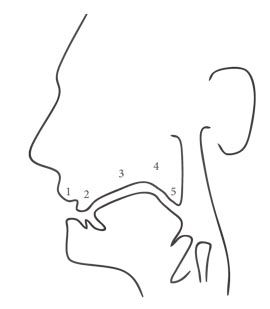Consonants
Of the 26 letters and letter combinations used in the Alutiiq orthography, 22 are consonants. Most of the consonants are represented by single characters, but seven consonants are represented by symbol combinations (gw, hm, hn, hng, kw, ll, ng).
Consonants differ from vowels in that consonants always involve some degree of obstruction of airflow in the mouth. With vowels, there is no obstruction of airflow.
Consonants are organized by how they are produced in the mouth (known as consonant type) as well as where they are produced in the mouth (location of production). Depending on the manner and in which they are produced in your mouth, consonants can be classified as stops, fricatives, or nasals. A stop means that the air coming out of your mouth is stopped briefly, and then released, as with the letter p. A fricative consonant is produced by constricting airflow, or as the name implies, producing friction (but not a full stop) in the airflow. An example of a fricative consonant is the letter s. A nasal consonant is produced by forcing air through the nasal passages rather the mouth. The letter m is a nasal consonant.
Click on the sound file below to hear each consonant sound following the consonant chart, beginning with the labial consonants and working right.
Each of the three major types of consonants is produced in different parts of the mouth.
| Consonant Type |
Labial: lips (1) |
Apical: tip of tongue (2) |
Laminal: blade of tongue (3) |
Velar: roof of mouth (4) |
Rounded Velar: roof of mouth and rounded lips (4) |
Uvular: back of mouth (5) |
| Stops | P | t | c | k | kw | q |
| Voiced Fricatives | l | y | w | |||
| Voiceless Fricatives | f | ll | s | g | gw | r |
| Voiced Nasals | m | n | ng | |||
| Voiceless Nasals | hm | hn | hng | |||
| Russian | R |
As seen in the table above, consonants can be organized by type as well as location of production. Figure 2 below shows the 5 locations within the mouth that consonants are produced.
Locations of Sound Production

Don’t Miss a Word!
Sign up for our email broadcast and we’ll send you a weekly language lesson and a link to our podcast.
Language Lessons
- Alutiiq – What is in a Name?
- Alutiiq and other Alaskan Languages
- Origins of the Alutiiq Alphabet
- Dialects and Styles of Alutiiq
- Language Loss & Revitalization
- Alutiiq Orthography
- Aapit – Alphabet
- Vowels
- Doubled Vowels & Diphthongs
- Consonants
- Stop Consonants
- Fricative Consonants
- Nasal Consonants
- Softening of Consonants
- Alutiiq Grammar: An Overview
- Pluralization
- Working with Noun Stems
- Working with Verb Stems
- Suffixes and Other Word Endings
- Postbases and Joining
- Alutiiq in Correspondence
- Kodiak Alutiiq Place Names
- Alutiiq Numbers
